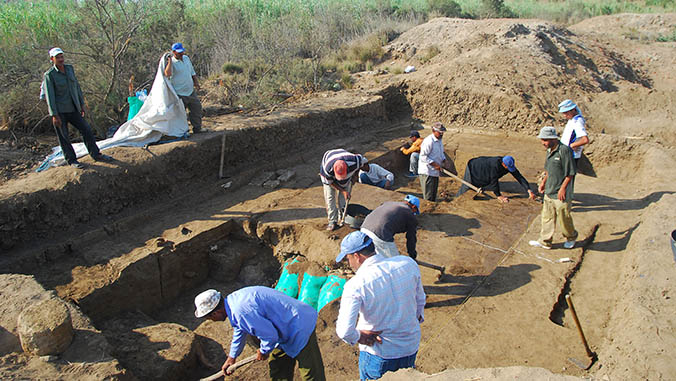
Egypt, known for the pyramids and the sphinx, is the summer destination for three University of Hawaiʻi at Mānoa students who are part of the Classics program in the College of Arts, Languages and Letters. They will spend five weeks in an ancient Egyptian city in the Nile Delta through July 31. The exotic journey is part of the UH Tell Timai Project, where students participate in archaeological activities at the Tell Timai site, which was a flourishing city from 500 B.C. to about 600 A.D. for the Egyptians followed by Greeks and then the Romans.
“The students will get training in archaeological methods, learn about material remains, and relate material culture to the written records,” said Robert Littman, a classics professor who has spearheaded the project since its inception in 2009. “By working on the remains of an ancient city they will gain greater understanding of the history of mankind.”
To date, more than 50 UH Mānoa students have traveled to Egypt where they assist in high-tech surveys and meticulous digging to uncover the settlement’s buildings and artifacts, such as pottery, coins and broken columns. Kali Konopko just earned her BA in classics this spring. The aspiring law school student has been enthralled with Egyptian artifacts and coins since she was a young girl.
“It’ll be nice to be able to immerse myself in a world that I’ve studied since I was little,” Konopko said. “It’s just gonna be amazing to re-create the culture for myself and being able to see the pyramids and the Valley of the Kings and Queens and make it real.”
According to Littman, students must study up to two years of ancient Egyptian language and written texts as a prerequisite for the trip. It’s a realm Becca Lensing, a PhD candidate in marine biology at UH Mānoa, fell into by chance during the COVID-19 pandemic. Unable to complete much work outside of her home in 2020, she decided to enroll in Littman’s ancient civilization course online. The microbiologist developed a fascination with hieroglyphics and ancient Egyptian bread.
“One of the reasons I’m interested in ancient baking is, I believe it tasted better back then. Us modern people, we’re just not baking the bread in the same way as they did.”
Lensing is hoping to find old beer bottles at the excavation site that still carry traces of liquid she hopes to use as yeast to bake batches of bread reminiscent of old Egypt.
Cleopatra perfume
In 2012, Littman and UH Mānoa adjunct professor Jay Silverstein uncovered what was thought to be the house of a perfume merchant at the Tell Timai site. The UH professors found glass kilns containing some sort of liquid that later analysis and recreation by perfume experts using ancient Greek texts, led to the reproduction of the myrrh (a natural gum or resin extracted from a number of small, thorny tree species)-based Mendesian and the Metopian perfumes that some claim may have been worn by the famed Egyptian ruler, Cleopatra.
- Related UH News story: Cleopatra’s ancient perfume recreated, July 30, 2019

